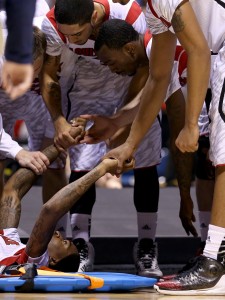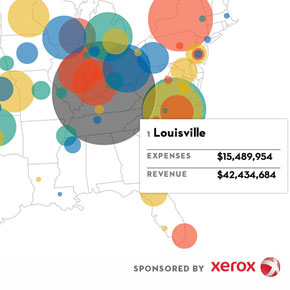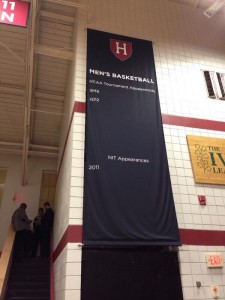This special March Madness episode features Princeton University women’s basketball head coach Courtney Banghart on the Tigers undefeated regular season and playing in the Ivy League, Andy Challenger of Challenger, Gray & Christmas on the estimated $1.9 billion loss of wages during the NCAA tournament and Chris Smith of Forbes on the most valuable programs in college basketball.
Instant Bracketification: Final Four Edition
 I remember when Tim Krumrie broke his ankle in Super Bowl XXIII and as horrifying as the slow motion of his dangling appendage was, it pails in comparison to the stomach turning agony of what happened to Louisville’s Kevin Ware on Sunday night. To watch the scene unfold after Ware crumpled awkwardly to the ground, his shin shattered at a near 60 degree angle, was to witness both the pain and beauty of athletic competition.
I remember when Tim Krumrie broke his ankle in Super Bowl XXIII and as horrifying as the slow motion of his dangling appendage was, it pails in comparison to the stomach turning agony of what happened to Louisville’s Kevin Ware on Sunday night. To watch the scene unfold after Ware crumpled awkwardly to the ground, his shin shattered at a near 60 degree angle, was to witness both the pain and beauty of athletic competition.
The reason many of us play organized sports is because of the camaraderie that develops with teammates and the self sacrifice involved in achieving a collective goal. To be clear we are not talking about war, there is no comparison between the beaches of Normandy and the hardwood of Indianapolis, but the scene in Lucas Oil Stadium after Ware’s injury, with his teammates huddling around him holding his arms as he was lifted onto a flat board stretcher, was as touching and inspring a moment as I can remember witnessing. If this overly sentimental hyperbole makes you nauseous I apologize. But be honest, upon hearing that all Ware could say to his Louisville teammates as he was lying flat on his back with a compound fracture, an injury that he may never fully recover from, was ‘Just win the game’ it’s impossible not to be overwhelmed by this simple act of selflessness.
Back to business, Wichita St plays angry but the Cardinals play fast and unlike the Ohio State Buckeyes, the Shockers elite 8 opponent, Louisville can fill it up. Siva and Smith are as good as any guards in the country at getting to the basket and Deng is a human eraser around the rim. Sometimes teams will experience an emotional letdown following a traumatic event but Louisville didn’t show any signs of being distracted during their second half demolition of Duke so it’ll be best not bet against them in Atlanta.
On the other side of the bracket, Syracuse and Michigan are two incredibly long, athletic teams riding a couple of impressive win streaks. In theory the Wolverines shouldn’t have as much of an issue as Indiana di in trying to navigate Syracuse’s 2-3 zone. John Beilein is a master technician of the zone defense and has years of experience taking on the Orange back during his days with West Virginia. If anything this game will come down to the Michigan defense being able to pester rangy tweeners like Southerland and Fair. Michigan in a mild upset.
March Madness: Follow The Money
 Your sports infographic of the day comes from of all places the New Yorker that final bastion of meandering profiles and incongruent animal cartoons. This particular interactive feature charts out March Madness results by budget with a specific eye towards determining whether or not the money a college basketball programs spends and earns determines their success in the NCAA tournament. For instance, Kansas, the top seed in the south region, has $13M in expenses compared to $16M in revenue. Conversely, Western Kentucky, the Jayhawks second round opponent, spent only $3M with $3M in revenue. So, was money the primary reason Kansas defeated Western Kentucky by a final score of 64-57 or are there other more important factors involved?
Your sports infographic of the day comes from of all places the New Yorker that final bastion of meandering profiles and incongruent animal cartoons. This particular interactive feature charts out March Madness results by budget with a specific eye towards determining whether or not the money a college basketball programs spends and earns determines their success in the NCAA tournament. For instance, Kansas, the top seed in the south region, has $13M in expenses compared to $16M in revenue. Conversely, Western Kentucky, the Jayhawks second round opponent, spent only $3M with $3M in revenue. So, was money the primary reason Kansas defeated Western Kentucky by a final score of 64-57 or are there other more important factors involved?
In my opinion it’s hard not to listen to Deep Throat and “follow the money” as programs like Kansas can afford to spend more money to attract the best coaches who’ll then be given access to vast amounts of recruiting resources which will help them attract the nation’s best high school basketball talent. If each round of the NCAA tournament was played as best of 7 series then you’d normally see the bigger budgeted programs win out. But because it’s single elimination schools like Florida Gulf Coast, $1M expenses, can defeat two schools, Georgetown $10M and San Diego St $4M, that spend a lot more money. The irony is that with FGC’s improbable run to the Sweet 16 school regents are scrambling to raise the cash necessary to keep coach Andy Enfield around for a few more years.
Take a look at this New Yorker article, it’s really interesting and who knows, may come in handy as you fill out the remainder of your bracket. – JL
Instant Bracketification: Sweet Sixteen Edition
 Welcome back to work America as we gear up for the Easter holiday and another heavy dose of college basketball starting Thursday. I took a quick glance at the brackets this morning and here is what I could come up with for a quick preview of the Sweet Sixteen.
Welcome back to work America as we gear up for the Easter holiday and another heavy dose of college basketball starting Thursday. I took a quick glance at the brackets this morning and here is what I could come up with for a quick preview of the Sweet Sixteen.
Midwest (Indianapolis)
(12) Oregon is the best example of the NCAA selection committee screwing up tournament seedings as the Ducks are obviously much better than a #12. (2) Duke is led by Mason Plumlee a really athletic, active big man who reminds me of those super zombies from Will Smith’s I Am Legend. My original pick (3) Michigan St. is still going strong, even after that unfortunate towel throwing incident, amd I won’t switch directions even though with each game (1) Louisville suffocates their competition it is becoming increasingly likely that the Cardinals roll into Atlanta without so much as sweating through a single digit game.
West (Los Angeles)
(9) Wichita St. is a well coached mid major representing the Valley Conference, the best conference nickname name in all of collegiate athletics, well ahead of the Big Ten’s Legends and Leaders, and (13) La Salle, or “The Salle”, is named after my 2nd favorite European explorer right behind Jacques Cartier who “discovered” what is now known as the St. Lawrence River. Neither of these teams stand a chance against either (2) Ohio St. who lives to fight another round thanks to Aaron Craft’s last second 3-pointer against Temple, and (6) Arizona. Fans are generally split on Craft with race being brought up as a factor in how you potentially view the Buckeye point guard. White, black or orange the kid always plays the game at full speed and has the cojones to take the big shot, which is part of the reason I’m sticking with my original pick of OSU.
East (Washington)
(4) Syracuse is flying under the radar right now mostly because they played their second and third round games out in San Jose but also because all people can talk about is the looming NCAA bombshell that could potentially invalidate all the Orange accomplish this March. I’d love to pick (3) Marquette, my 6th favorite explorer, but find it hard to go against (1) Indiana even though the Hoosiers will face a stern test in (2) Miami. And regarding my earlier pick of UNLV, I was under the incorrect assumption that the Running Rebels were still being led by Stacey Augmon and Larry Johnson which is why I mistakenly took them to reach the Final Four.
South (Arlington, Tx)
(4) Michigan is today’s trendy pick after blowing out yesterday’s soup du jour VCU and here’s hoping the basketball team has more success in Cowboy Stadium than the Wolverine football team which was destroyed by eventual national champions Alabama in Arlington last fall. (1) Kansas is solid but not flashy which is the exact opposite of (15) Florida Gulf Coast, a school that even Siri believes doesn’t exists. The Eagles are now unfortunately facing some minor backlash following their jubilant dismissal of San Diego St which should be expected from older internet trolls who long for the days of Vince Lombardi and “act like you’ve been there before and you’ll be there again”. The (3) Florida Gators and Billy Donovan have been there before and are the best bet to get there again this year.
Semifinals
Michigan St over Ohio St
Florida over Indiana
National Championship
Florida over Indiana
Harvard Wins One For The NESCAC
 Harvard’s win over New Mexico in the second round of the NCAA tournament was good news for all of us hoping to see the New England Small Conference Athletic Conference make the leap to DI athletics. The Ivy League, just like the NESCAC, does not award athletic scholarships, which certainly didn’t look like it mattered Thursday evening as the Crimson’s speed around the perimeter created a lot of open three point shots exposing the sluggish Lobo defense, eventually busting a whole bunch of NCAA brackets.
Harvard’s win over New Mexico in the second round of the NCAA tournament was good news for all of us hoping to see the New England Small Conference Athletic Conference make the leap to DI athletics. The Ivy League, just like the NESCAC, does not award athletic scholarships, which certainly didn’t look like it mattered Thursday evening as the Crimson’s speed around the perimeter created a lot of open three point shots exposing the sluggish Lobo defense, eventually busting a whole bunch of NCAA brackets.
The NESCAC is at the top of DIII athletics with schools like Williams, Bowdoin, and Trinity competing at some of the highest levels of collegiate competition regardless of level. ‘Cac schools do not award athletic scholarships relying instead on massive endowments to award need based scholarships to offset the exorbitant costs of higher education helping to create and promote socio-economic diversity. Generally NESCAC schools are smaller than the Ivies but the infrastructure exists within some of these rural New England institutions to increase the size of the student body and properly support DI athletic programs.
The questions for the NESCAC is why should they make the move to DI? The answer is simple: exposure and revenue. The NESCAC brand is already strong with over achieving high schoolers looking for an alternative to the Ivy and Patriot Leagues and adding DI athletics would not dilute the applicant pool but rather serve to increase the national profile of schools that are still relying heavily on the Northeast to fill their dormitories. More bodies in beds means more tuition money. Plus former NESCAC athletes like myself would love the move which will lead to an increase in school pride and a rise in annual giving.
Plus with Big Ten commissioner Jim Delany threatening a move to DIII should Ed O’Bannon’s lawsuit against the NCAA go through there could all of a sudden be a massive void in top tier collegiate athletics which could be filled by the likes of Wesleyan, Amherst, and Tufts. I say the NESCAC should call Delany’s bluff and 10 years from now I want to be talking about the Bates College Bobcats pushing Butler in the second round of the NCAA tournament. Ok, maybe not Bates but you get my point. – JL





